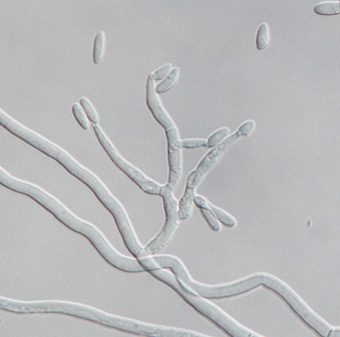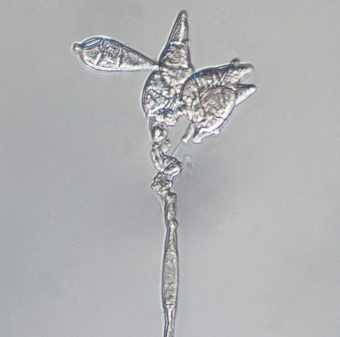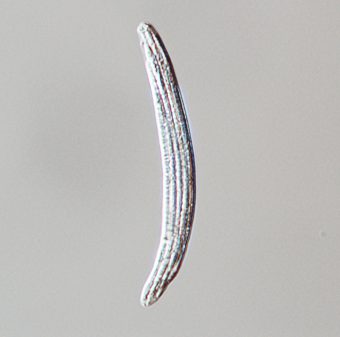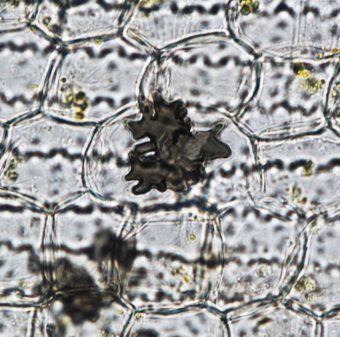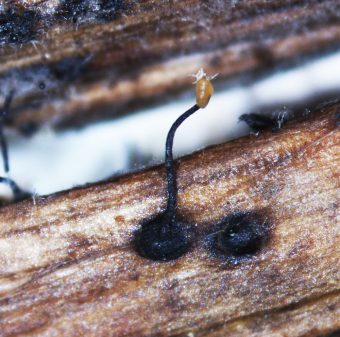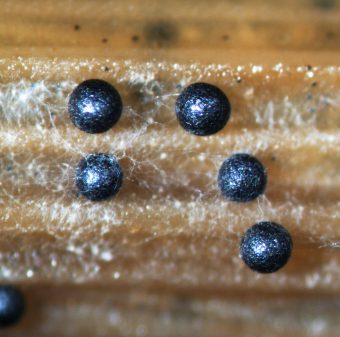The order Magnaporthales (Sordariomycetes, Ascomycota) includes economically and scientifically important cereal and grass pathogens, such as the rice blast fungus Pyricularia oryzae (syn. Magnaporthe oryzae), the take-all root rot pathogen of cereals Gaeumannomyces graminis, and the summer patch pathogen of turfgrasses Magnaporthiopsis poae, which are all model organisms in fungal biology and host-pathogen interaction studies. The best-studied species is the rice blast fungus, which is one of the most devastating threats to food source in the world. Each year this pathogen destroys enough rice to feed 60 million people. It also infects turfgrasses causing the gray leaf spot of perennial ryegrass and tall fescue. The rice blast fungus is fast evolving. The wheat isolates arose in Brazil in the 1980s cause a new disease of wheat (wheat blast), which has dispersed to other countries in South America, and is a potential threat to wheat production in North America and other parts of the world (Urashima et al. 1993; Urashima and Silva 2011). This order also contains endophytes and saprotrophs that occur in terrestrial and aquatic habits. To date, over 200 species have been described in Magnaporthales, about 50% of which are pathogens of domesticated and wild monocots.
Species in Magnaporthales are morphologically characterized by perithecia, which are solitary to gregarious, superficial to submerged in host tissues, without a stroma, black to dark brown, globose to subglobose, smooth to hairy, and with a prominent, cylindrical, and black to brown neck. The paraphyses are well developed, hyaline, septate, and gradually tapering, and usually dissolving at maturity. The asci are unitunicate, cylindrical to clavate, 8-spored, and with a refractive apical ring. The ascospores are uniseriate to multiseriate in the ascus, hyaline to yellowish, fusiform, fusoid to filiform, septate, and smooth.
The asexual morphs of Magnaporthales exhibit two major types of conidial developments, harpophora-like and pyricularia-like (Cannon 1994; Thongkantha et al. 2009; Luo and Zhang 2013; Luo et al. 2015b). Phialidic conidiogenesis is found from simple conidiophores in Harpophora and Phialophora, pycnothyria in Pseudotracylla, sporodochia in Mycoleptodiscus, and synnemata in Didymobotryum; denticulate conidiogenesis is shown by rhexolytic secession in Nakataea and Pyricularia, and schizolytic secession in Clasterosporium (Cannon 1994; Cannon and Alcorn 1994; Gams 2000; Réblová 2006; Huhndorf et al. 2008).
Some Magnaporthales can also produce specialized infection structures when colonizing their host plants, known as runner hyphae, appressorium, and hyphopodium. The hyphal pressing organs can generate strong turgor pressure to penetrate the host cells (Dean et al. 2005).
Due to such pleomorphy, the taxonomy and systematics of Magnaporthales fungi have remained obscure for a long time. Recent advancement in gene, transcriptome, and genome sequencing of Magnaporthales fungi have resulted in robust phylogenies, which correspond well with the pathogenicity, ecology, and biology of these taxa. The taxonomic concepts are thereby revised in recent studies (Thongkantha et al. 2009; Luo and Zhang 2013; Luo et al. 2015a, b; Klaubauf et al. 2014; Hernández-Restrepo et al. 2016, Luo et al. 2017; Vines et al. 2019).
The aim of this monograph is to provide a comprehensive taxonomic overview of Magnaporthales at the order, family, genera, and species levels by integrating morphological, biological, ecological, and molecular characteristics. Dichotomous keys to the three families and 32 genera in the order Magnaporthales are generated, and all accepted species names are included under each family. On the basis of literature and specimen examination, species description, diagnostic illustration, type designation, host range, geographical distribution, and literature are provided for representative taxa, especially the type species for each genus. These updated taxonomic, biogeography and molecular data will facilitate the future work on systematics, biodiversity, evolution, genetics, plant protection, and quarantine.
Copyright 2022 by The American Phytopathological Society. Reproduced, by permission, from Luo, J., and Zhang, N. 2022. The Rice Blast Fungus and Allied Species: A Monograph of the Fungal Order Magnaporthales (https://my.apsnet.org/APSStore/Product-Detail.aspx?WebsiteKey=2661527A-8D44-496C-A730-8CFEB6239BE7&iProductCode=46826). American Phytopathological Society, St. Paul, MN.

